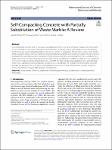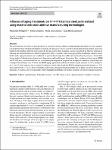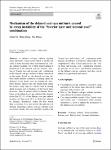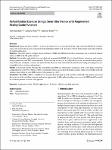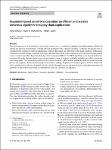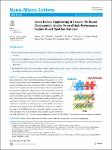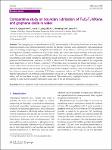Search
Author
- T. S., Amer (2)
- A., Meana-Fernández (1)
- A., Moreau (1)
- Aaliya, Sarfaraz (1)
- next >
Subject
- 17–4 PH stainless stee... (1)
- 1D-CNNs (1)
- 3CL protease (1)
- Absorbance measurement (1)
- next >
Search Results
Self-compacting concrete (SCC) is also seen as unsustainable since it uses a lot of natural resources. Recent researchers have focused on lowering construction costs and partially replacing cement with industrial waste. It is possible to effectively use various industrial wastes in concrete as cement or aggregates. Among these wastes, waste marble (WM) is a useful choice, and researchers have been interested in using WM in concrete for a couple of years. However, to pinpoint the advantages and recent advancements of research on WM as an ingredient of SCC, a comprehensive study is necessary. Therefore, the purpose of this study is to do a compressive evaluation of WM as an SCC ingredient. |
The most relevant criticalities of parts produced by material extrusion additive manufacturing technologies are lower mechanical properties than standard material performances, the presence of pores caused by the manufacturing method, and issues related to the interface between layers and rods. In this context, heat treatments can be considered an effective solution for tailoring the material behavior to different application fields, especially when using precipitation hardening stainless steels. In this work, aging treatments were conducted on parts realized using three different extrusion-based processes: Atomic Diffusion Additive Manufacturing, bound metal deposition, and fused filament fabrication. |
A delayed coal–gas outburst incident often represents a more severe threat to health and safety of mine personnel than an instantaneous coal–gas outburst incident. For a better understanding of mechanism of the delayed coal–gas outburst, structure of “barrier layer and tectonic coal” combination in the delayed coal–gas outburst is firstly introduced in this paper. Based on, the delayed coal–gas outburst under different conditions of mining depth and thickness of the barrier layer are numerically simulated. Results indicate that the barrier layer enters the tertiary creep stage in a shorter time as mining depth increases and as thickness of the barrier layer decreases. Then we analyze effect of dynamic disturbance on the delayed coal–gas outburst. |
Smart-bar device (SBD) is a newly developed device to measure the body range of motion (ROM) by a kinetic sensor and to provide an exercise program with augmented reality (AR) guidance of body-frame image and audio feedback by mobile application. |
Dynamical systems are often subject to algebraic constraints in conjunction with their governing ordinary differential equations. In particular, multibody systems are commonly subject to configuration constraints that define kinematic compatibility between the motion of different bodies. A full-scale numerical simulation of such constrained problems is challenging, making reduced-order models (ROMs) of paramount importance. In this work, we show how to use spectral submanifolds (SSMs) to construct rigorous ROMs for mechanical systems with configuration constraints. These SSM-based ROMs enable the direct extraction of backbone curves and forced response curves and facilitate efficient bifurcation analysis. We demonstrate the effectiveness of this SSM-based reduction procedure on seve... |
The growing interest in blockchain technology has gained a lot of attention in Supply Chain Management (SCM) and sparked the quest for decentralized, scalable, efficient and trustworthy consensus schemes. Traditional blockchains rely on computationally expensive consensus mechanisms with low throughput and high latency. This paper conducts a performance evaluation of several existing consensus protocols to illustrate blockchain’s shortcomings in terms of consensus and propose a new consensus algorithm: Reputation based proof of cooperation (RPoC). The RPoC algorithm uses a layered architecture to segment the nodes that participate in the consensus phase in order to improve scalability and efficiency while maintaining trust among peers. |
EBUNet: a fast and accurate semantic segmentation network with lightweight efficient bottleneck unit It has been difficult to achieve a suitable balance between effectiveness and efficiency in lightweight semantic segmentation networks in recent years. The goal of this work is to present an efficient and reliable semantic segmentation method called EBUNet, which is aimed at achieving a favorable trade-off between inference speed and prediction accuracy. Initially, we develop an Efficient Bottleneck Unit (EBU) that employs depth-wise convolution and depth-wise dilated convolution to obtain adequate features with moderate computation costs. Then, we developed a novel Image Partition Attention Module (IPAM), which divides feature maps into subregions and generates attention weights based on them. As a third step, we developed a novel lightweight attention decoder with which to retriev... |
Seizure prediction algorithms have been central in the field of data analysis for the improvement of epileptic patients’ lives. The most recent advancements of which include the use of deep neural networks to present an optimized, accurate seizure prediction system. This work puts forth deep learning methods to automate the process of epileptic seizure detection with electroencephalogram (EEG) signals as input; both a patient-specific and general approach are followed. EEG signals are time structure series motivating the use of sequence algorithms such as temporal convolutional neural networks (TCNNs), and long short-term memory networks. We then compare this methodology to other prior pre-implemented structures, including our previous work for seizure prediction using machine learn... |
Sodium-based dual-ion batteries (SDIBs) have gained tremendous attention due to their virtues of high operating voltage and low cost, yet it remains a tough challenge for the development of ideal anode material of SDIBs featuring with high kinetics and long durability. Herein, we report the design and fabrication of N-doped carbon film-modified niobium sulfur–selenium (NbSSe/NC) nanosheets architecture, which holds favorable merits for Na+ storage of enlarged interlayer space, improved electrical conductivity, as well as enhanced reaction reversibility, endowing it with high capacity, high-rate capability and high cycling stability. The combined electrochemical studies with density functional theory calculation reveal that the enriched defects in such nanosheets architecture can ben... |
The emerging use of two-dimensional (2D) nanomaterials as boundary lubricants in water offers numerous benefits over oil-based lubricants; whereas the friction reduction varies significantly with nanomaterial type, size, loading, morphology, etc. Graphene oxide (GO) and Ti3C2Tx MXene, a relatively new 2D material, are investigated as boundary lubricants in water in this study. The contact pair mainly includes Si3N4 balls and Si wafer. The results found (1) monodispersed GO offers better lubricity than monodispersed MXene under identical concentration and testing conditions; and (2) the mixed dispersion of GO and MXene (0.1 mg/ml: 0.1 mg/ml) produced the lowest friction coefficient of ∼ 0.021, a value 4× and 10× lower than that produced by comparable mono-dispersions of GO or MXene, ... |

